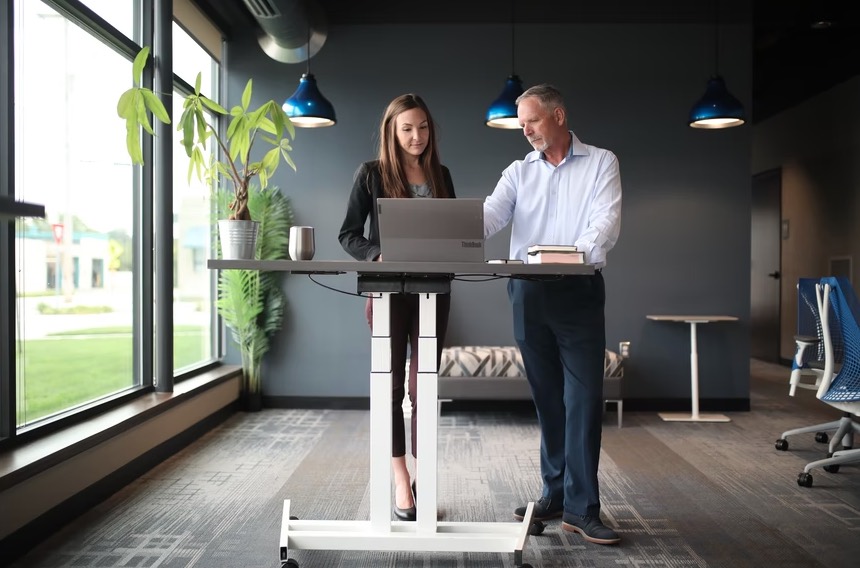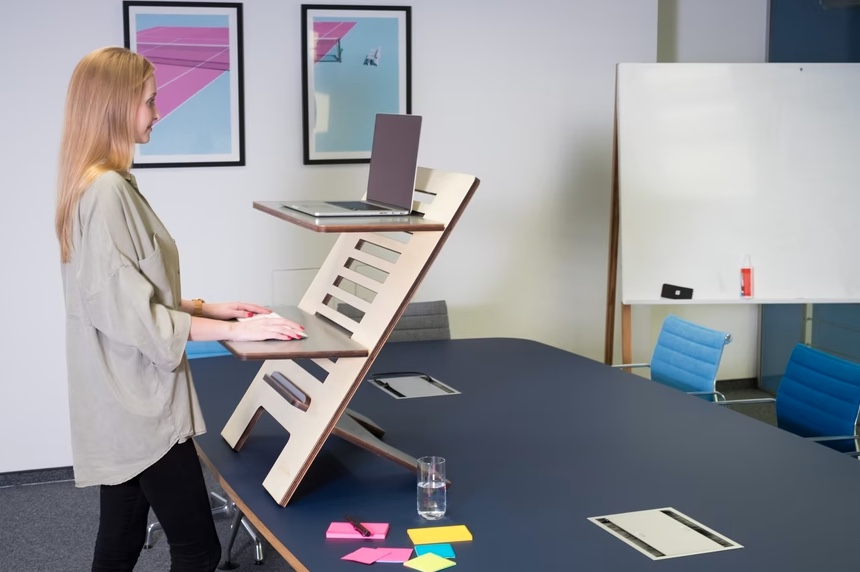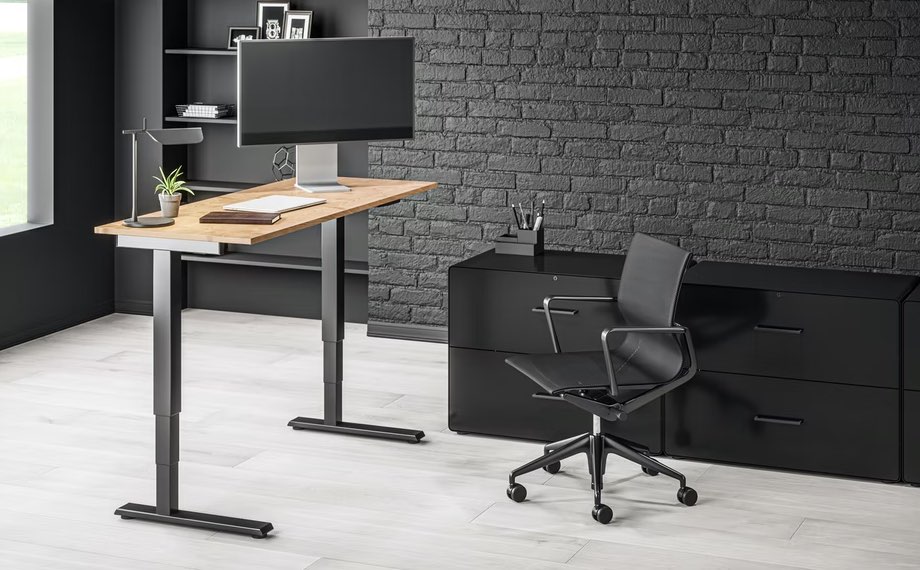Whether your morning commute takes you downtown to an office building or just down the hallway, the way you set up your workstation can significantly impact your health. You may have heard the phrase, “Sitting is the new smoking.” Research suggests that sitting — even in an ergonomic office chair — in one place for an extended period of time can be detrimental to both mental and physical health. One Australian study found that prolonged sitting was a risk factor for all-cause mortality; participants who sat more than 11 hours a day saw a 40 percent greater chance of dying within three years when compared to those who sat for fewer than four hours a day, regardless of the person’s physical activity when not sitting. Yikes!
It’s no wonder that many people have made the shift to using a stand-up desk. However, it’s important to note that standing all day presents its own problems. So when it comes to creating an office environment that supports your health, a workstation that allows you to alternate sitting and standing postures with sit-stand ergonomic solutions may be your best bet; research suggests adjustable workstations can reduce back discomfort without negatively impacting productivity.
Ready to upgrade your office with an adjustable stand-up desk? Before you make a decision on the right office desk for you, take a moment to make sure you’re familiar with the different options available. Once you look through this stand-up desk buying guide, you’ll have no trouble choosing the best stand-up desk for your needs!
It’s common knowledge that sitting is “the new smoking” with many of us averaging over 9 hours a day sitting at a desk. In fact, according to fastcodesign.com, “85% of workers experience discomfort on the job” especially in situations where they aren’t able to change postures during the day. As more companies began to focus on improving wellbeing in the workplace, it’s no wonder that sit-stand desks (or stand-up desks or sit-to-stand desks or height adjustable desks) are becoming increasingly popular.
While exploring the possibility of sit-stand desks you’re bound to have some questions: Are best standing desk base right for me? How do I decide which height adjustable desk is best? Do they come in a range of prices? And how can I ensure my ROI on stand-up desks and guarantee that they will be used?
First of all, we should note that standing all day can be just as harmful as sitting all day. The best option is to change postures intermittently, moving often from sitting to standing and even perching at a stool height counter. The ideal candidate for a sit-stand desk is generally someone who is tied to a computer or phone at a desk and can’t easily get up to switch postures.
Another important consideration is the way in which you execute the rollout of sit-stand desks in your office. You could go all out (if you have the means) and give everyone a height-adjustable desk, but often this is not feasible. A practical option is setting up shared sit-stand workstations throughout the office for people to use as needed. Lastly, many companies reserve the option to have a stand-up desk for people who have medical issues that require them.
Regardless, when choosing an adjustable height desk it’s important to ensure that you consider all the options and thoughtfully evaluate how your people will use them. That way you can guarantee they get used! Here are 10 things to consider when choosing a height-adjustable desk.
Purpose-Built Or Add-On?
The first fork in the road for anyone considering a standing desk is to decide between a setup that’s purpose-built for standing and addition that converts your existing desk for that function.
If you like your existing desk, it’s worth exploring the add-on options first. But if you aren’t too enthused with it, you’ll probably want to go for a new one that lets you stand. In my experience, most of those are in the $600–$1,000 range, and most tend to offer a good desk to sit at plus the ability to easily adjust your work surface up and down. A few of the more popular options I looked at include StandDesk, UpDesk’s UpWrite, and UpLift 900. Navigate to this website.
The Basics of Ergonomics
First step in picking a desk: Make sure it's the right height, says Carolyn Sommerich, an associate professor of systems engineering at Ohio State University. Whether you're sitting or standing, when you're typing your forearms should be parallel to the ground, your elbows at around a 90-degree angle, and your feet flat on the floor. When you're sitting, your hips and knees should also be at an optimum 90-degree angle.
Experts stress that if you're even a little taller or shorter than average, you shouldn't assume that all standing desks will accommodate you. So grab a tape measure and a friend to measure from the floor to the bottom of your bent elbow while standing and sitting. That's how high above the floor the keyboard should be, in both its raised and lowered positions. Also measure your seated and standing eye level, which is where your monitor should be placed, so you can look forward at your screen, not up or down.
In general, a wider the range of adjustment is almost always better; the devices tend to be most stable when they're not at their max height.
A few quick tips: If you're not ready to commit to a standing desk, or the model you want is back-ordered right now, an ironing board makes a surprisingly good substitute, according to University of Cincinnati public health sciences professor Kermit Davis.
Plan to stand on a mat in supportive shoes to protect your joints, especially if you'll be standing on a concrete or tile floor. Finally, if you have lots of equipment with power cords, Ethernet cables, and other wires, think about how you'll hook those up as you're shopping. For instance, you may need to invest in longer cords, or decide to get a wireless, rather than wired, keyboard.
Stand-up desk options
As with any piece of furniture, there’s a wide variety of stand-up desks on the market — and the best one for you may be different than the best option for your colleague. Let’s take a look at some of the most common options.
- Fixed stand-up desks
While we’re mainly focusing on adjustable stand-up desks, it’s worth noting that a fixed standing desk may be the only way to incorporate a standing posture in some situations. If a worker will spend many hours at a fixed stand-up desk, it’s vital that the desk be adjusted to their height and that there’s a stool available to use in a perching posture. An anti-fatigue mat can also help reduce discomfort. Ideally, anyone who uses a fixed stand-up desk should also have access to an area where they can work for intervals while seated. - Adjustable sit-to-stand desks
You can find a height-adjustable table or desk in both electric and manual versions. With an adjustable desk that allows you to sit or stand, it’s easy to move from one position to the other and back again multiple times throughout the day without needing to move your computer or papers from one surface to another. (We’ll discuss the pros and cons of electric versus manual desks below.)
As you shop for your adjustable desk, keep in mind that you’ll need your new workstation to perform the same duties your current one does. Do you store files or supplies in your desk drawers? Make sure to look for an adjustable desk that offers storage. Need to power lots of devices? Keep your eyes peeled for an adjustable desk with built-in features such as USB ports or charging stations. - Standing desk converters
Adding a standing desk converter to your current desk may be the simplest way to achieve your sitting and standing goals. These converters, which come in all kinds of designs and at a variety of price points, can be used with a normal desk. If you love the desk you have or work in an office where getting a whole new desk isn’t an option, you can simply use a converter, set it on top of your desk, and adjust to your heart’s content. - Swing arm adaptors
Mounting a laptop or monitor on a swing arm adaptor, which clamps to the back of an existing desk or table, can make for an easy conversion option, especially if you work in a small space. Swing arm adaptors are affordable and easy to install, but it can be difficult to maintain proper typing ergonomics with this option unless you have a separate keyboard (and something to boost the keyboard while you’re standing). Click to find out more. - Adjustable desks for treadmills and bikes
Adding an under-desk treadmill or bike to your workspace can help you incorporate more movement into your day — but it narrows the field a bit when it comes to which desks will work for you. Some manufacturers only offer their office-friendly treadmills or bikes as combined workstations, meaning the desk comes with the treadmill or bike and may not offer the adjustability to use it for sitting or standing.
What To Consider?
Manual Adjusting Desks
In our experience of trying out standing desks, and according to the many people we've talked to, having to manually adjust the height of your desk (usually with a hand crank) is a pain. It doesn't sound time-consuming to take a minute to adjust your desk, but if you're switching from sitting to standing and back to sitting several times per hour, it adds up. What we've found is that many users start to reduce the amount of switching they do, and they revert to their old habit: sitting. And as standing desks become more popular, their prices are coming down. It won't cost that much more to go hydraulic or to have an electric motor.
Hydraulic Desks
This is a great option if you need a desk that adjusts quietly. These desks don't require any strength to adjust. You will find this option in one of the most expensive standing desks, the Focal Locus.
Electric Adjustment
This is the most common type of standing desk, and there are several things to consider with electric desks. If you're working in a quiet office, you're going to want to look for a quieter desk. Measured in decibels, the range is generally between 40-70 decibels. Whispering in a library is around 30 decibels, while a normal conversation is 60-65 decibels. Regarding the speed that the desk switches positions, the range is generally 0.7 inches/second to 1.7 inches/second.
Weight Capacity
This might not seem important initially, but if you're used to having a lot of stuff on your desk, you have to consider how much weight the motor can handle. And remember that the tabletop has to be included in the weight that the motor will be lifting. Desks on the low end will only lift 50 lbs. If you're not sure how much your stuff weighs, take everything you have on your desk right now and weigh it. If the tabletop of the desk you're considering isn't listed, call the manufacturer to find out how much it weighs. On the high end, some desks can lift a whopping 700 lbs!
Programmability
Electric desks will often have several memory settings, similar to what you have in some car seats. So if you share your desk with family or office workers, having 2-4 presets can save you time in adjusting, as you can just press a button and the desk will adjust to the perfect height for you.
Minimum and Maximum Height
This can be an issue if you're especially tall or short. The range is generally from 21-56 inches. When you're standing, you should be able to type with your elbows at your sides and your forearms slightly angled down towards the floor. Your monitor should be positioned at eye level. For more detailed information, check out our Guide to Proper Workplace Ergonomics.
Tabletop
For most standing desk users, the size of the tabletop is an important consideration. That's partly why many people choose to buy a frame and build their own tabletop. If you're used to having lots of stuff on your desk, make sure the size of your desk can accommodate everything you need. You'll also need to consider the amount of room you have in your office for your desk. Tabletops are made from several different materials, including particleboard, plastic, bamboo, carbonized bamboo, steel, 3D laminate, oak, or walnut.
Warranty
There are several warranties offered by different standing desk companies. The minimum is 2 years, and some companies offer a lifetime warranty on the base or the frame and a limited time warranty on the tabletop or the motor.
Shipping and Assembly
Some desks aren't pre-made, and it can take up to 8 weeks for your desk to be delivered! Make sure you check on how long it will take, as many desks won't be delivered in a few days. Shipping generally costs $100-$150, and some companies will give you the option of "white-glove service," where they build your desk for you in the spot where you want to use it.
Special Features
With some desks, you can add upgrades such as a tray to hold and hide the wires, a net to hold various items, or a keyboard tray. Beyond these options, each desk may have unique features that you won't find with other desks, such as:
- The desk syncs with your phone, giving you information about how long you've been standing or sitting and how many calories you've burned. You can also give commands to raise and lower the desk.
- You can write on the tabletop.
- A lightly textured tabletop that's more responsive to using a mouse (this desk is designed for gaming).
- Built-in speakers.
Height range
BIFMA suggests an optimal range being 22.6″ to 48.7″ but it will depend upon the height and needs of the individual using the desk. If people are sharing the sit-stand desk then it’s best to find a desk with a large range. Additional reading.
Depth
A 30″ depth is advisable as a minimum but this is taking into consideration that people will want to spread out their work. If that’s not an issue you can look at smaller footprints. Additionally, bear in mind there are often multiple options for the shape of the work surface.
Noise
Is the mechanism loud and disruptive or is it unobtrusive? When sit-stand desks are noisy they are often not utilized for fear of disturbing colleagues.
Ease of movement.
There are numerous ways to raise and lower desks, from hand cranks to electric or pneumatic lifts. The latter two being the most quiet, efficient, and easy to use.
Speed
How quickly does it raise/lower. Obviously, the quicker the speed, the more often people will adjust their worksurfaces throughout the day.
Power
Make sure if you choose a height adjustable desk that requires power that you have easy access to electricity.
Leg fatigue
One common complaint from people using sit-stand desks is that they get tired standing. Some strategies include; wearing supportive shoes, adding a riser to support one foot while standing, adding a gel mat and encouraging people to slowly build up their tolerance by incrementally adding to the time they stand.
Weight
Each desk has its own weight restrictions, make sure the desk can handle your equipment.
Read Reviews!
The standing desk industry is still in its infancy, so there's a range of quality, options, and performance issues. Read lots of reviews and pay attention to stability issues. Some standing desks become wobbly when raised, and some are just unstable in general, which will cause your monitor to shake when you type.
If you plan to have a separate treadmill or bike to use under your desk, make sure the desk you choose accommodates the height you need. For example, keep in mind that walking on a treadmill likely adds several inches to your desk height needs. You’ll also want to make sure your desk is very stable. After all, you’ll be moving — and you don’t want your movement to make your desk feel rickety or knock your computer to the ground!
Frequently Asked Questions About Standing Desk
To begin, set your standing desk at about elbow height. This means your elbows should be in a 90-degree position from the floor. As a guide, the average 5'11” (180 cm) person would have their desk about 44 inches (111 cm) high.
MoveSafe believes that although standing desks can be beneficial they are not required for most people. What is more important is remembering to take frequent Movement Breaks throughout the workday and sit with good ergonomic posture.
You should stand at a standing desk for 30 to 60 minutes at a time. You should spend approximately an hour standing for every hour to two hours that you spend sitting.
The Pros. Besides less sitting time, standing at work has other benefits: More calories burned: One study showed that standing sheds 88 calories an hour, compared to 80 calories for sitting. Walking burns a lot more -- 210 calories an hour.
Our bodies naturally settle into a neutral position with an arched or slouched back. Whether sitting or standing, this position can strain your bones and muscles, causing pain. When you set up your standing desk, adjust the desk height so your head, neck, and spine are aligned.
When using a standing desk, it's nice to sometimes lean on it the way you would a countertop. To keep it from rolling away from you, make sure the wheels are in their “locked” position.





